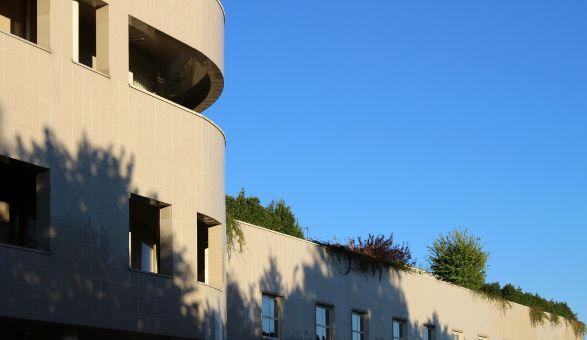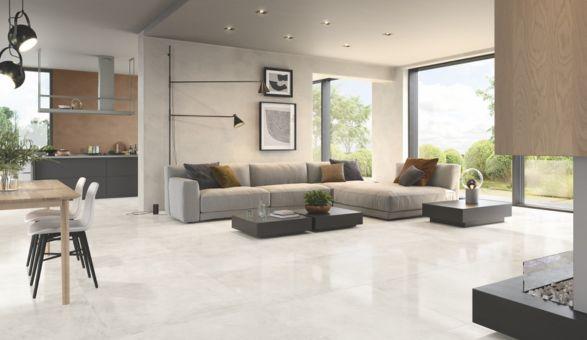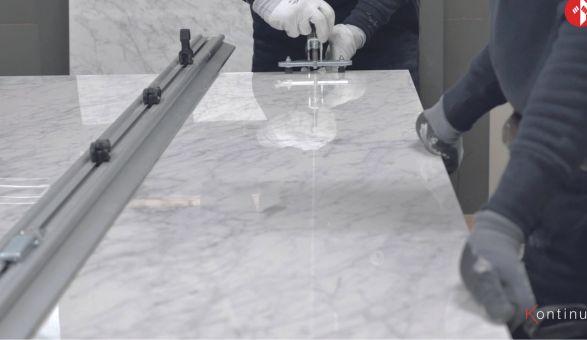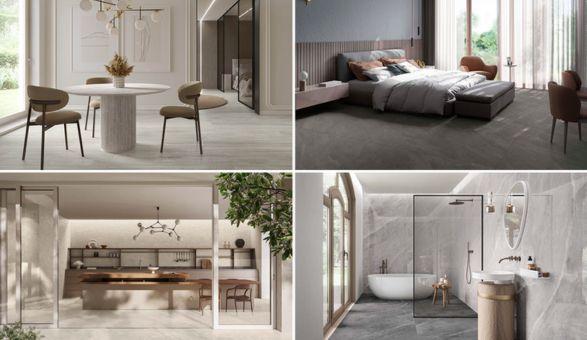FAQ
Porcelain stoneware is a compact (non-porous) coloured ceramic material obtained through pressing. The French word "gres" indicates that the ceramic body of the tile is highly vitrified and compact, which is what gives it its exceptional resistance to impacts, scratches, stains, chemicals, flexure, and abrasion. Porcelain stoneware is also an extremely hygienic material. The word “porcelain” underlines the refined elegance that characterises this material and derives from the use of kaolin, a type of white clay that is also used for making porcelain.
Porcelain stoneware is obtained from a mixture of clay and feldspar fired in a kiln at extremely high temperatures (1200-1300 °C) until it reaches a level of non-porous vitrification and impermeability that makes the tiles highly water-repellent and with high mechanical strength even without glazing.
Unglazed porcelain stoneware tiles are characterised by the continuity between the surface and the substrate, whereas in glazed tiles you can distinguish the substrate and the glaze.
A tile’s shade is the shade of colour of a given batch of porcelain stoneware tiles. Its calibre is the facial dimension of the tile. For reasons depending on the manufacturing technology, porcelain stoneware tiles may have slightly different dimensions (a few millimetres) after the firing process. That’s why they are grouped in such a way as to classify them under the same size, thereby meeting the minimum tolerances set out in the applicable standards in force.
Porcelain stoneware tile rectification is a process through which the edges of the tiles are perfectly squared to give the surface a natural effect. This way, the tiles can be laid very tightly together or with barely noticeable joints.
Rectification is the result of machining using a rectifying machine equipped with a hard fine-grit grinding wheel to ensure fine finishes.
There is no right product. There are, however, tiles that are more suited than others for the place they are intended for.
When it comes to grout lines there’s no one size fits all.
Given its exceptional qualities, our rectified porcelain stoneware can be laid with minimal grout lines. The minimum recommended grout size varies in each country.
In the UK, it’s 2mm for walls and 3mm for floors. In the event of multi-format laying, the width of the grout joints can be determined by combining the various formats as desired.
There is no one answer when it comes to the colour of the grout joints. We recommend tone-on-tone with the flooring.
All tiles from the Granitogres, Pietre Native, Granitoker and Gresplus collections can be used for cladding.
You can use tiles from our collections in any colour and in the size suited to their intended use (ventilated wall, external insulation layers, traditional glueing). However, keep in mind that for traditional glueing and external insulation layers, you should prefer light colours with a solar reflectance index higher than 20.
There are no size limits for ventilated façades. However, the most widely used are the 60x120 cm, 120x 120 cm and 120x260 cm sizes (and their submultiples). For external insulation layers, we recommend small or medium small sizes, such as the 30x60 cm and 60x60 cm formats. Do not exceed 45x90 cm or 60x120 cm.
For outdoor flooring, we recommend Extragres 2.0, a series of 20 mm thick perfectly squared and rectified monolith porcelain stoneware tiles featuring a non-slip surface finish, from the Amazzonia, Country Wood, Parchi, Pietra Baugé, Pietre di Sardegna e Kerblock collections.
Extragres 2.0 tiles can be dry laid onto grass, gravel, and sand to obtain a floor that can be immediately walked on. They can also be glued onto a screed, thereby ensuring high resistance to loads, or they can be laid onto polypropylene (PP) substrates, available with fixed or adjustable heights, to create outdoor raised floors that conceal electrical wiring and water piping in the cavity below.
For public swimming pools, we have specific tiles manufactured to meet standards in force. These tiles are often used for semi-public and private pools too.
The German DIN 51097 standard usually applies to swimming pools. This standard divides barefoot floors into three categories (A, B, and C) and establishes that the flooring around a pool must have at least a group B classification.
After carefully measuring the floor or wall surface, you should consider about 10% more for cuts and scraps that may be necessary during the laying phase and for possible repairs in the future.
Our porcelain stoneware tiles are easy to clean and lay, hygienic and resistant to mould and moss thanks to the Bios Antibacterial treatment. They are also resistant to stains (ensuring high-performance indoor and outdoor floorings under any use condition), non-absorbent and fireproof (and, in the event of a fire, they do not release substances harmful to humans and the environment). They are frost-resistant and remain unchanged in any climate condition.
Casalgrande Padana tiles are made in a closed-loop production process, which means that any production waste, including wastewater, is treated and reused. All components are recycled and recovered using special systems. The emissions resulting from the production process are purified through abatement systems that exploit the best technologies to comply with the limitations established by law.
Casalgrande Padana’s environmental policy is also implemented through green procurement criteria to promote the selection of sustainable suppliers and reduce the environmental impact upstream of our activities and products. We have developed a project, which we pursue through integrated and comprehensive regulations and standards that outline the causes and tools to prevent, or minimise, environmental impact. Our ISO 14001 certification, the EMAS Regulation and our Leed certification are significant milestones in this process.
For routine everyday cleaning, all you have to do is wash the flooring/wall covering with water and normal detergents suitable for ceramic surfaces (use gel detergents on wall coverings).
Ensure that the detergents do not contain waxy substances.
Should there be any stubborn stain that cannot be removed by routine cleaning, use a stain cleaner for porcelain stoneware. Apply it to the stain without water and let it sit for long enough. Then, rub hard until the tiles are back to their original condition.
Note that porcelain stoneware is resistant to any chemical, except hydrofluoric acid, which eats into any ceramic and, therefore, must never be used.
The purpose of first-time cleaning is to remove any trace of cement or plaster used to close the joints. The flooring/wall covering is normally cleaned once before use. This must be done before the flooring/wall covering is used in the following way:
1. Sweep the floor/covering to remove the coarser dirt.
2. Dampen the surface with water so as to soak the joints, thereby protecting them from the corrosive action of the acid detergent (descaling product).
3. Apply acid detergent in the concentration (water mixing ratio) indicated by the manufacturer, using a manual or motorised brush. Avoid any contact between the acid detergent and the steel, aluminium, and natural marble components near the flooring/wall covering.
4. Let the detergent sit as long as needed, depending on the condition of the floor. Then, rub any stubborn dirt away (and scrape off residues of mortar or plaster).
5. Rinse the flooring/covering with water and mop up the dirty water immediately (manually or with a washer/drier). With regards to the Metallica series, use highly diluted detergents (1:5 dilution i.e., 1 part acid to 5 parts water) and rinse thoroughly to remove any acid residue from the surface. If the flooring/wall covering is cleaned for the first time after being used, it is important to use appropriate alkaline detergents (degreasing agents) before applying the acid detergent to remove any greasy or similar substance. If necessary, you can repeat the first-time cleaning operations described above. Learn more
Need to make circular holes or openings in our porcelain stoneware slabs to make room for sanitary fixture pipes, the toilet cistern, recessed spotlights, electrical ducting or wall sockets, and you don't know how?
Follow our instructions and watch our video tutorials.
You need to cut our porcelain stoneware tiles and don't know how? Follow our advice and watch our video tutorial.







